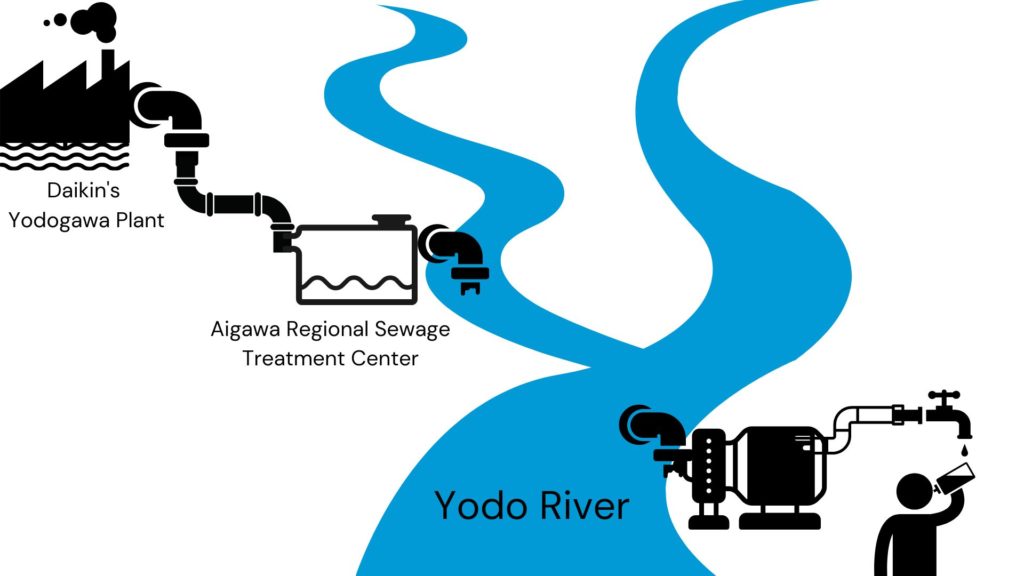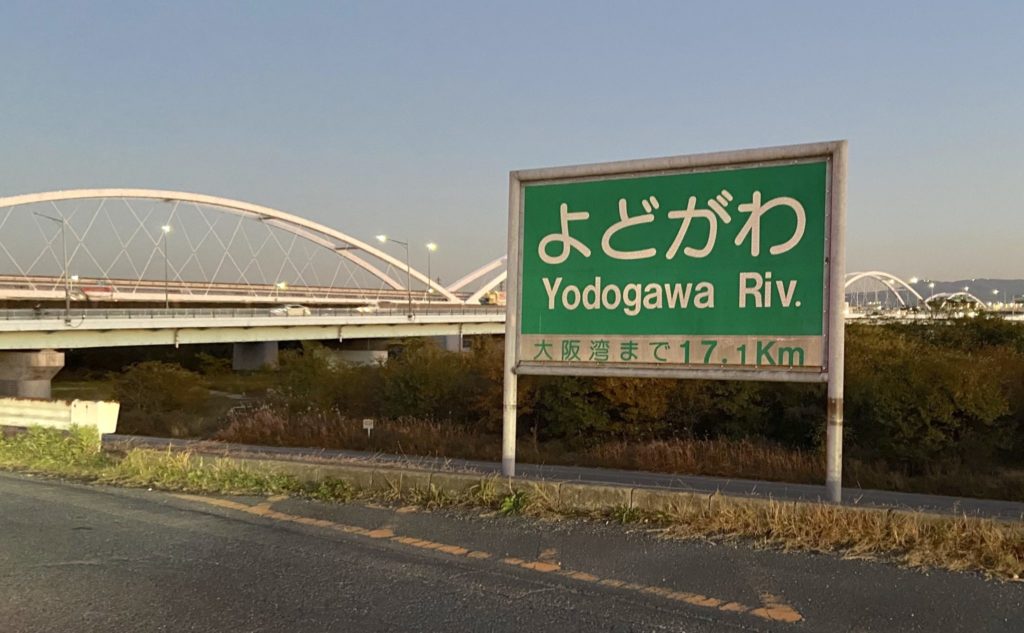Daikin Yodogawa Plant Still Discharging PFOA Outside Its Premises While Concealing the Concentration, Draining Wastewater into Tap Water
2023.05.30 13:42 Nanami Nakagawa
Yodogawa Plant of Daikin Industries, Ltd. in Settsu City, Osaka Prefecture is still discharging PFOA outside the premises.
Daikin announced that it stopped manufacturing PFOA in 2012. However, groundwater containing high concentrations of PFOA is still accumulating on the factory premises. Daikin “purifies” groundwater before discharging it into a sewage treatment plant. After passing through the sewage treatment plant, it flows into the Yodo River and some of it becomes drinking water.
However, the concentration of PFOA-contaminated water discharged by Daikin is still unknown. Residents have repeatedly asked Daikin to make the concentration public, but Daikin has refused.
Residents’ concerns are only growing.
Pointed-out by a Kyoto University Professor
On March 8, 2023, a citizen group that aims to address PFOA pollution, consisting of residents of Settsu City, Osaka, submitted 23,788 signatures to the Ministry of the Environment. It calls on the government and Daikin to deal with the problem of the country’s highest level of PFOA contamination in Settsu City.
After submitting the signatures, a citizen group that aims to address PFOA pollution in Settsu held a press conference. Professor Emeritus Akio Koizumi of Kyoto University, who is a pioneer of PFOA research in Japan, and Associate Professor Koji Harada attended the press conference as well. Koizumi and Harada answered technical questions from the press on behalf of citizens.
A Ryukyu Shimpo reporter asked a question.
“The production of PFOA that Daikin was discharging ended in 2012. So, is it correct to say that there is no outflow at this point?”
Harada answered, “They’re storing groundwater and draining it now to the sewer. So I would think that it’s actually still being discharged.”
What does that mean?
Pollution in the name of “countermeasures”
Daikin has two “countermeasures” for PFOA pollution around the Yodogawa Plant.
The first is the impermeable wall that will surround the Yodogawa Plant. An iron plate will be driven into the basement to prevent contaminated water from flowing out of the site.
The other is to pump up groundwater containing PFOA at the Yodogawa Plant, purify it, and discharge it into the public sewage system. Currently, 60,000 tons of groundwater are pumped out annually. Kyoto University’s Harada pointed out that ”discharges are still taking place,” referring to this countermeasure.
I have reviewed the records of closed meetings by Daikin, Settsu City and Osaka Prefecture. The three parties have been discussing countermeasures against PFOA pollution since 2009. In the materials of the most recent meeting held on August 8, 2022, I found a description of PFOA emissions outside the factory premises.
According to the meeting materials, Osaka Prefecture had requested Daikin to thoroughly manage the emission concentration with a target of 10 times the provisional guideline value.
The provisional guideline value is the target value of 50 ng/l in the water environment set by the Ministry of the Environment. Osaka Prefecture is demanding that 10 times that amount be discharged into the sewage system.
However, the concentration of PFOA-contaminated water that Daikin actually discharges outside the site is unknown. There is no mention of it in the past meeting records. The Osaka Prefecture has only made a “request” to Daikin, and has not even asked for the actual figures.
If Daikin does not sufficiently reduce PFOA levels in its emissions, it could lead to further pollution. Isn’t it enough just to prevent the Yodogawa Plant’s groundwater from leaking out of the premises through impermeable walls?
I asked Harada about Daikin’s “countermeasures.”
Regarding measures to purify the groundwater on the premises and discharge it into the sewer, Harada points out, “It’s unclear how much the concentration in the surrounding area can be reduced.”
Nevertheless, regarding the measures to install impermeable walls, he said, “If the impermeable layer is firmly blocked in accordance with the flow of groundwater, the spread should be stopped.”
However, although the impermeable wall was scheduled to start construction by the end of March 2023, it has not yet been installed.
Same pollution route as 20 years ago
I recalled something when I heard Harada’s argument at the press conference. The current route of PFOA-contaminated water that Daikin discharges is the same as that of the past, which caused the world’s highest known concentration of PFOA.
In 2004, Koizumi and his team at Kyoto University investigated PFOA concentrations in 80 rivers across Japan, from Hokkaido to Kyushu. Harada is also one of the members. As a result of the survey, the world’s highest level of PFOA at that time was detected in the Aigawa River, a tributary of the Yodo River. The concentration ranges from 67,000 ng/l to 87,000 ng/l, which is 1,340 to 1,740 times higher than the current target set by the Ministry of the Environment.
Further research revealed that the source of the pollution was the Daikin’s Yodogawa Plant, which operates near the Aigawa River. Wastewater from the Yodogawa Plant first flows into the Aigawa Regional Sewage Treatment Center. The team confirmed that 1.8 kilograms of PFOA were being discharged from the sewage treatment plant every day. That’s half a ton per year. At the time, the total amount of PFOA released into waterways worldwide was five tons per year. Ten percent of the global total was coming from the Yodogawa Plant.
Furthermore, at that time, high concentrations of PFOA were detected in the blood of residents of Kyoto-Osaka-Hyogo region. Tap water in Osaka City, whose residents showed the highest levels of PFOA, contained 40 ng/l of the chemical — 300 times higher than the concentration found in Sendai’s tap water. Osaka City mainly used water from the Yodogawa River.
Based on these findings, Koizumi and his team concluded the following.
・PFOA discharged from plants that manufacture it first goes to sewage treatment plants, which are unable to completely remove it.
・After being expelled from sewage treatment plants, water containing PFOA joins rivers.
・Residents drink tap water gathered from said rivers.
・Residents absorb PFOA into their bodies.

Route of PFOA-contaminated water discharged from the Yodogawa Plant of Daikin Industries (created by Tansa)
It is not possible to simply compare this time with the time when the world’s highest level of pollution was recorded 19 years ago. However, the route by which the PFOA-contaminated water from Daikin’s Yodogawa Plant reaches the Yodo River is the same. Residents of Settsu and neighboring cities cannot rest assured unless Daikin publishes the concentration.
Residents who want to know the concentration
The citizens of Settsu who submitted the petition are demanding that Daikin disclose the PFOA concentration in the wastewater discharged to the sewage system. The first item on the petition is the following:
Since October 2009, more than 20 meetings have been held between Osaka Prefecture, Daikin, and Settsu City without the public’s knowledge. It has been pointed out that high-concentrated PFOA contamination spreads within Daikin’s premises. Daikin pumps up 60,000 tons of groundwater annually, purifies it, and discharges it into public sewage, but does not even disclose the PFOA concentration in that water. In order to prevent leaks to the surroundings, it is necessary to disclose such information, investigate, and take countermeasures based on it.
However, Daikin refused to disclose the PFOA concentration in the wastewater. Citizens also asked to speak face-to-face, but were denied.
Masato Yoshii (pseudonym), who lives in Settsu City, cites PFOA pollution in the United States as an example.
“DuPont in the United States has released information to nearby residents who have caused damage. Why is Daikin covering it up forever?”
Concentration concealment using the guise of “manufacturing technology know-how”
I decided to ask Daikin directly about the concentration of PFOA in the wastewater. I sent a letter of inquiry to the president, Masanori Togawa, through public relations, but the president did not reply. Instead, I received a reply from the public relations office saying, “Our company’s public relations department will answer only the facts as follows.” However, the concentration was not disclosed.
Since it contains confidential information, such as manufacturing technology know-how, we will refrain from disclosing the details.
PFOA is a toxic substance whose manufacture and import were banned by law in 2021. Why does Daikin care about “manufacturing technology know-how” even though it can no longer be manufactured?
I also asked the following question:
Is there any objection to the fact that “Daikin Industries continues to emit high concentrations of PFOA outside the Yodogawa Plat site, polluting the area around the plant”?
Daikin did not answer that it had any objections, but replied, “We have received a request to ‘thoroughly manage the concentration with a target of 10 times the provisional guideline value,’ and we are responding to it.”
Finally, I asked why the public was not informed of the concentration of PFOA-contaminated water discharged into the public sewage system. Daikin answered:
Since it contains confidential information such as manufacturing technology know-how, we refrain from disclosing details. As for neighboring residents, we have taken appropriate measures in cooperation with Osaka Prefecture and Settsu City.
How is ignoring the complaints of neighboring residents an “appropriate response?” Where does Daikin’s inclination to dismiss the gravity of situations come from? I’ll discuss the report on a firsthand conversation with someone who represents Daikin’s real intention in the following story.

Signboard for the Yodogawa River along the road, near Daikin Industries’ Yodogawa Plant.
(Originally published in Japanese on May 1, 2023. Translation by Mana Shibata.)
Polluted with PFOA: All articles
 Newsletter signup
Newsletter signup